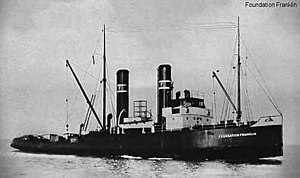Our website is made possible by displaying online advertisements to our visitors.
Please consider supporting us by disabling your ad blocker.
Foundation Franklin
 Foundation Franklin before World War II. Two "F"s are clearly visible on the twin funnels.
| |
| History | |
|---|---|
| Name | Frisky |
| Builder | John Lewis and Sons Shipbuilding, Aberdeen |
| Yard number | 67 |
| Laid down | 1918 |
| Launched | August 1918 |
| Completed | August 1918 |
| Commissioned | 1919 |
| Fate | Sold for commercial service 1924 |
| History | |
| Name |
|
| Owner | |
| Port of registry |
|
| Acquired | 1924 |
| In service | 1924 |
| Out of service | 1948 |
| Fate | Broken up for scrap 14 April 1949 |
| General characteristics as built | |
| Type | Tugboat |
| Tonnage | 613 GRT |
| Length | 47.3 m (155 ft 2 in) pp |
| Beam | 9.5 m (31 ft 2 in) |
| Draught | 4.3 m (14 ft) |
| Propulsion | Triple expansion steam engine, 1,200 hp (890 kW) |
| Speed | 15 knots (28 km/h; 17 mph) max |
SS Foundation Franklin was a seagoing salvage tug built for the Royal Navy as HMS Frisky in 1918. In 1924, the tugboat was sold and renamed Gustavo Ipland before being acquired in 1930 by Foundation Maritime and renamed Foundation Franklin. The tugboat became famous for many daring salvage operations and rescues between 1930 and 1949. Her many rescues and salvage triumphs were celebrated in Farley Mowat's book The Grey Seas Under. In 1948, the ship was damaged in a hurricane and not considered repairable. The tug was broken up for scrap in 1949 at Halifax, Nova Scotia.
Previous Page Next Page


